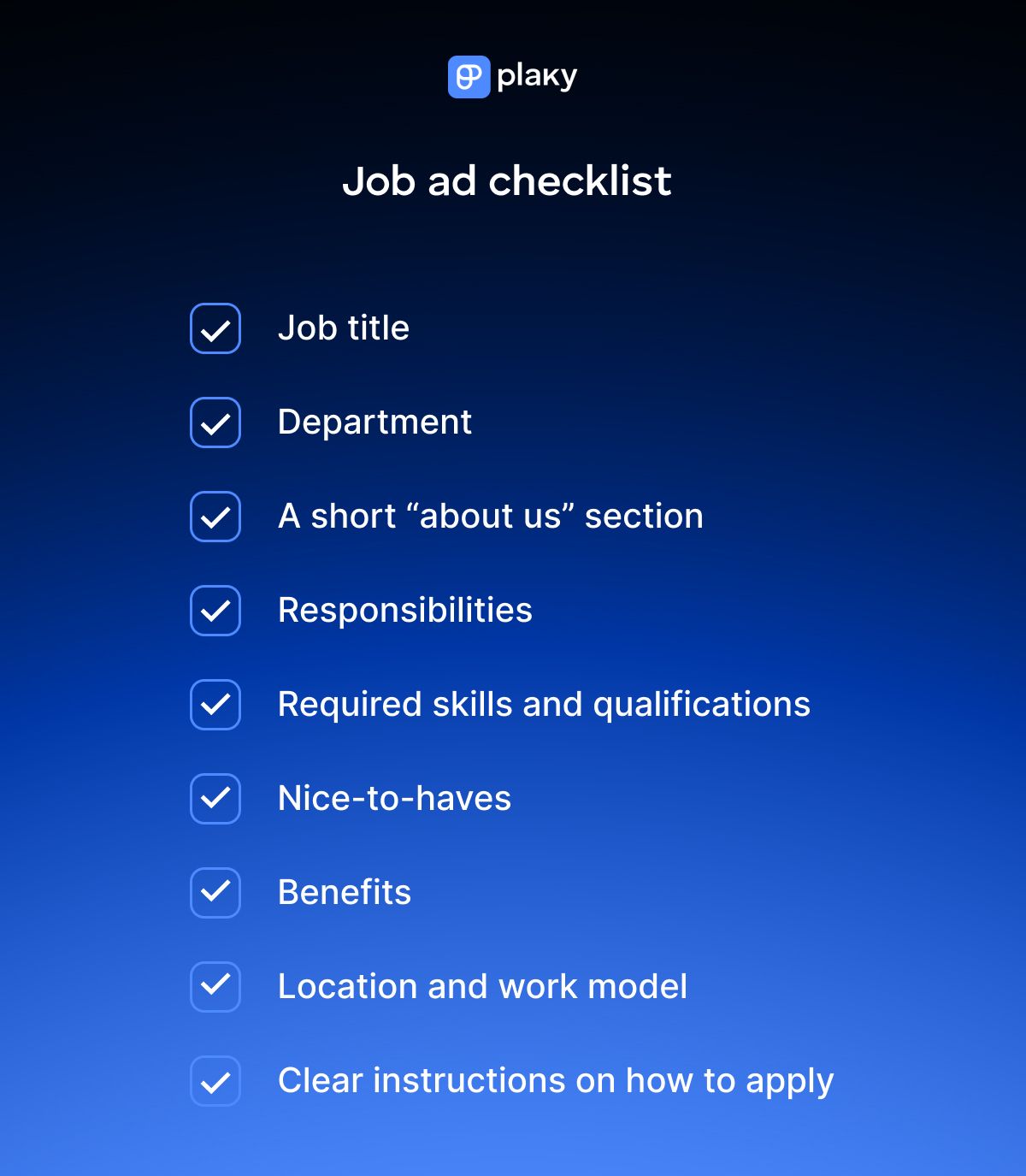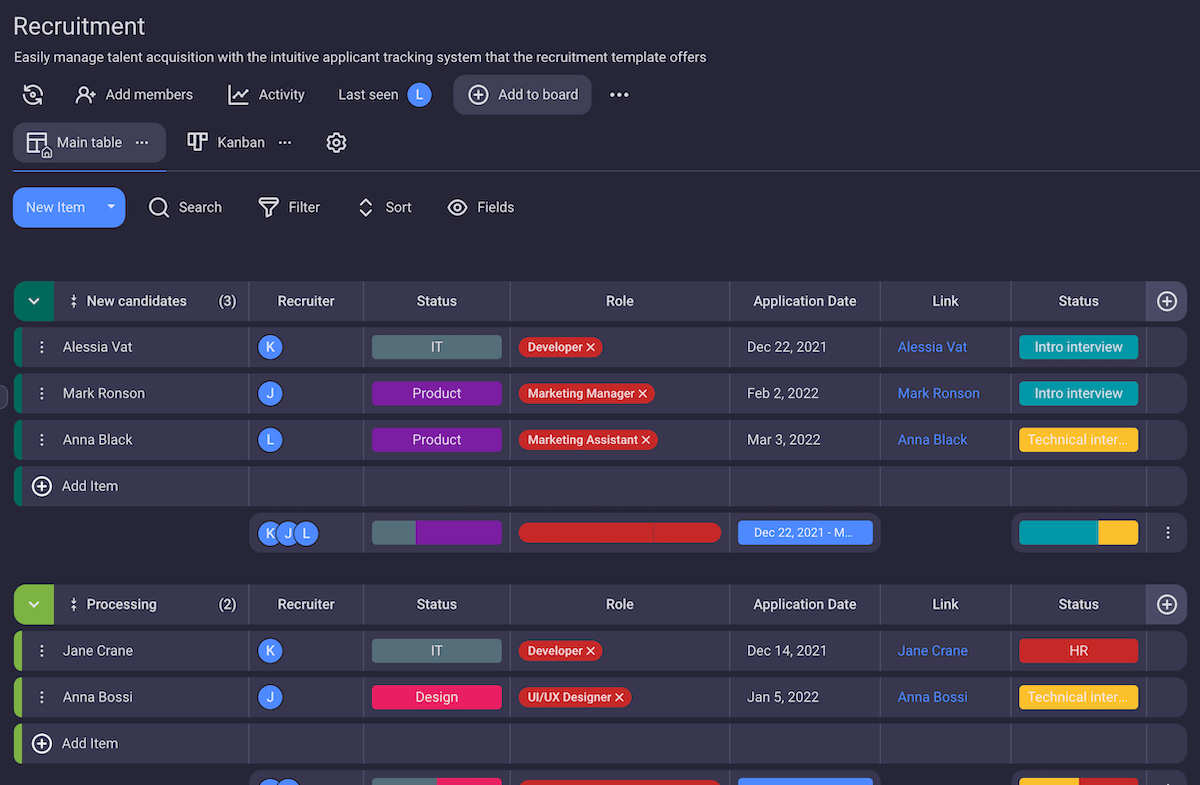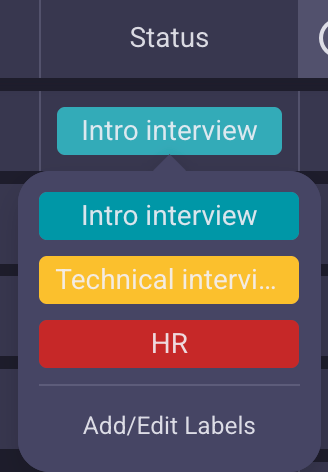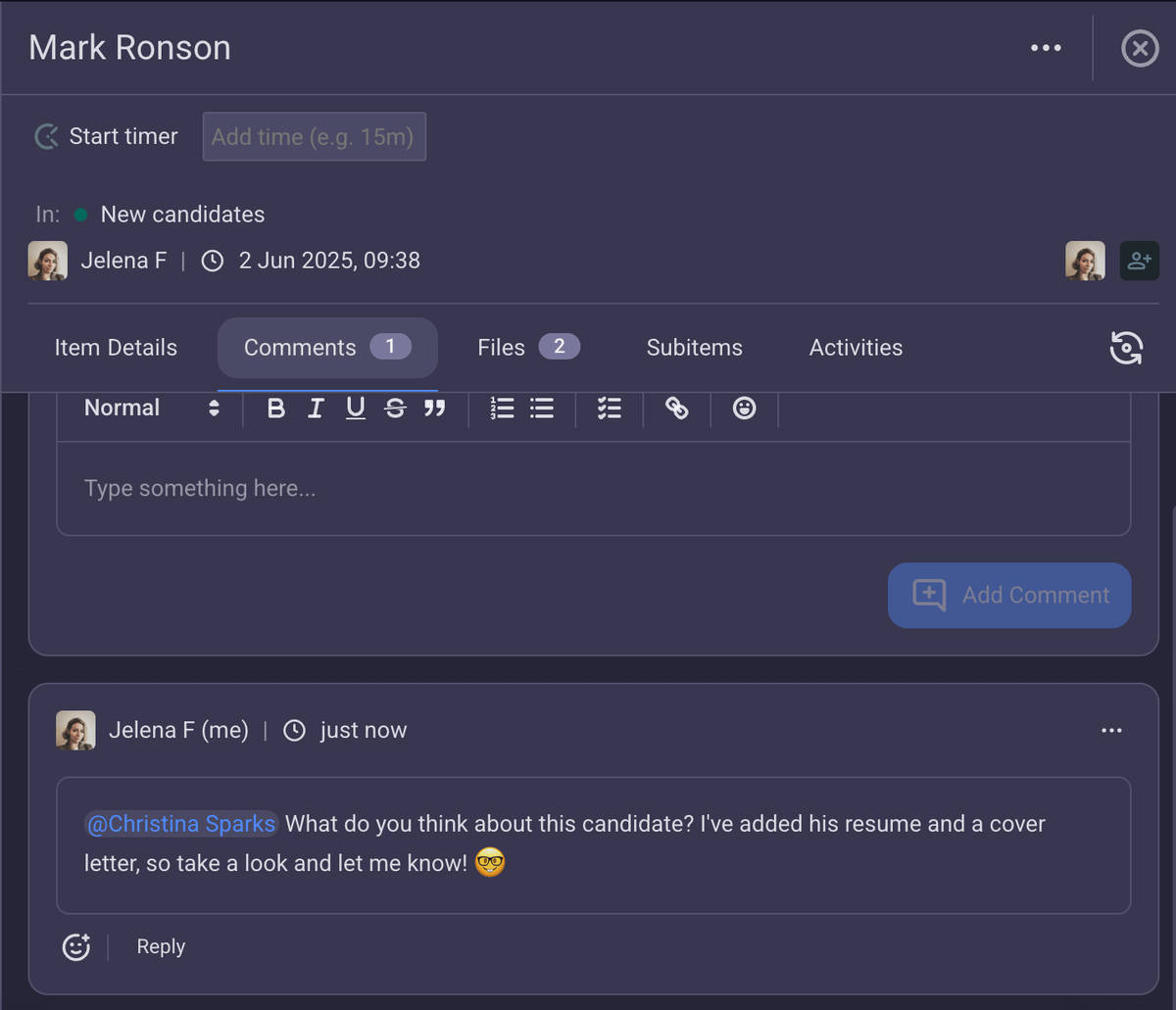Mary Kay Ash, a wildly successful businesswoman and billionaire who employed over 800,000 people in over 30 countries, once said: “A company is only as good as the people it keeps”.
It’s probably safe to assume that she knew what she was talking about.
According to the latest small business statistics, recruiting and retention are among the top challenges small business owners face. But, how do you get the right people to work for you?
This is the hard part, but don’t worry — we’ll shed some light on the recruitment process.
Let’s dive into the recruitment steps and techniques you can use to maximize your chances of hiring that perfect candidate!

In this article:
What is the recruitment process?
The recruitment process involves finding, screening, interviewing, and selecting the candidates whose skills, qualifications, experience, and character best fit the open position and the overall company culture. After that comes the hiring and then the onboarding process.
The recruitment of new employees is the primary role of Human Resource Management (HRM).
While the human resources department leads the recruitment process, many other employees — such as team leads and managers — are vital in selecting the right candidates too. As such, they are often actively involved in the hiring process.
💡 Plaky Pro Tip
Recruitment is just a small portion of what the HR department handles. If you want to learn more about how HR handles the management of their projects, check out the following blog post:
Benefits of a good recruitment process
A good recruitment process is one that:
- Manages to fill the vacant spot (which is the primary need of the company) by attracting a large number of competent candidates in a short amount of time and hiring the most qualified person for the position, and
- Minimizes the soft costs of hiring (e.g., the time recruiters spend on the recruitment process and the emotional impact and stress they go through) by streamlining recruiting and automating the areas that don’t require a human touch, thereby reducing the time needed to hire a new employee and increasing the process’s efficiency.
With that in mind, an efficient recruitment process is beneficial for a company as it:
- Establishes job requirements — It’s crucial to have clearly defined prerequisites for a role you’re hiring for, both for your and your candidates’ sake.
- Ensures that the candidates are qualified for the open role — This directly influences the quality of a business. Recruiters check whether the candidate has all the desirable characteristics and certifications to properly do the job.
- Helps maintain the workplace culture — HR professionals determine whether the candidates’ values align with the company’s. This is especially important for a positive work environment.
- Creates a better candidate experience — A positive interview experience not only helps you get the candidates you want but also helps with your branding. The candidates you’ve interviewed are likely to share their experiences with others on various platforms.
- Increases the success ratio of the selection process — The more you invest in your recruitment process, the better your chances of finding the right candidates.
7 steps for a successful recruitment process
As the term “recruitment process” suggests, this is not a one-time activity.
Successfully hiring new employees requires the smooth cooperation of many moving parts over a long period of time.
Here’s how to conduct a successful recruitment process in 7 steps.

#1 Defining the position and the ideal candidate
You can’t find what you’re looking for if you don’t know what that is.
In other words, you will miss out on a host of qualified candidates in your talent search if you:
- Fail to accurately understand the position you’re trying to fill, and
- Don’t accurately represent the responsibilities and benefits you’re offering.
As Michelle Hague, the HR manager at Solar Panels Network USA, says:

“First and foremost, it’s important to have a clear understanding of the vacancy you’re looking to fill. This means having a detailed job description that outlines the required skills and qualifications. Once you have this, you can start reaching out to potential candidates.”
She adds that you must make sure you’re attracting the right kind of candidate and advises to pay attention to the way you advertise the role.
For example, you might be looking for a new lawyer to join your legal team — but what kind of a lawyer do you need? Ask yourself the following questions:
- Do they need to specialize in a certain legal area?
- What will be their daily activities?
- Are there any particular qualifications they need to have?
- Is it a new position, or will they be replacing someone who quit?
- Will they get a full-time or a part-time contract?
The best way to be sure you’ve got everything right is to closely collaborate with the department where the vacancy is located.
This way, you can get a clear idea of your ideal candidate, while the new employee’s future manager can be sure that they’ll be getting exactly the kind of person they need.
#2 Crafting the job ad
Once you’ve profiled your ideal candidate and defined their responsibilities, putting together a job description should be fairly easy.
To make it even easier for you, we’ve created a quick checklist. Go through it to make sure you don’t miss anything important.

#3 Searching for talent
So, you’ve identified the duties and responsibilities of the vacant position and created the perfect job description.
The next step is to decide on the best way to fill it.
You can look within your organization or use employment websites. There are other ways to search for talent, but more on that later in the article.
#4 Screening and shortlisting
The vast majority of the applicants (75%, to be exact) are unqualified for the job, according to hiring statistics by Legaljobs.
Here are some ways you can make the screening and shortlisting process a bit easier:
- Use an automation tool — Since the majority of applicants are unfit for the job they apply for, knowing how to remove the lowest-quality candidates during the first pass is essential. Luckily, this can be done with software.
- Set the minimum criteria — After eliminating the first batch of candidates, it’s time to further narrow down the list by keeping only the people who meet the minimum requirements.
- Set shortlisting criteria — This is a good way to keep yourself focused when flipping through resumes instead of reading everything and getting lost in the sea of information.
- Limit your shortlist — This will force you to objectively evaluate the top candidates and choose the best ones.
- Note down interview questions for shortlisted candidates — Finally, it’s good to jot down a few questions specific to each shortlisted candidate in preparation for the interview. This way, you can confirm or eliminate any concerns you might have and further narrow down your search.

#5 Interviewing and selecting candidates
Once you have your shortlist ready, it’s time for the interviews.
There are several ways you can do this:
- Phone interviews — These are usually done as first or second-stage interviews and help the interviewers narrow down their candidate pool.
- Video interviews — This is a quick and easy way for interviewers to get to know their shortlisted candidates without forcing them to travel to the interview and wait for hours in the lobby. They are especially great when interviewing for remote positions.
- In-person interviews — These are mostly used as final or last-round interviews. For many, face-to-face interviews are still an irreplaceable part of the recruitment process — and the superior way to select the perfect candidate.
#6 Offering the job
We say “offer” because job seekers normally send their applications to several organizations, and even if they’ve reached the final stage in your company, it’s possible that other employers judged them to be a good fit for theirs as well. Therefore, it’s never guaranteed that the candidate will accept your job offer in the end.
This is why it’s important not to relax until the moment the contract is signed and refrain from keeping your candidates waiting for too long — otherwise, they might accept another offer in the meantime.
According to Michelle Hague, you should let your candidates know about your decision within 4 to 6 weeks from the beginning of the process:

“This gives us enough time to screen candidates, conduct interviews, and make a decision without keeping anyone in limbo for too long.”
Here are some tips on how to offer the job to your top pick:
- Stay polite and respectful.
- Don’t drop any new, previously undisclosed information.
- Give clear instructions on how to proceed in case your offer gets accepted.
- Clearly lay out all the conditions of employment and clarify any misunderstandings.
- Have one of the top executives make the final offer and welcome the new employee.
#7 Signing the contract and welcoming the new employee
The final step in the recruitment process is having the new employee sign the contract.
Unless the position is fully remote and the new employee is in a completely different country, the employee will normally come to the office to sign the contract.
This is an excellent opportunity to introduce them to all the people they’ll often be interacting with, such as the finance department, the IT technician, or the people they’ll directly be working under.
If the company provides new employees with equipment, this is also a good time to give them that equipment — so that the employee has everything they need on their first day.
It’s vital to make your new hire as comfortable as possible at the start of the process — after all, successful recruitment is the first step in creating a great employee experience.
After all this is done, the employee onboarding process can officially begin.
💡 Plaky Pro Tip
To make your employee onboarding process easier, you can use this helpful template:
Tips for effective recruitment
Now that we’ve gone through the entire recruitment process, here are some expert tips to look out for while filling roles at your company.
#1 Be specific in the job description
An employee must be aware of their responsibilities even before starting work. We spoke to Yari Ising, a business operations leader and recruiter, on how companies can achieve this. She warned us of the mistakes people make when crafting a job ad:

“As a recruiter, you always see the terms ‘duties as assigned’ on job descriptions, and managers tend to exploit that line. Those extra duties distract folks from doing good work, what they were hired for.”
So, make sure you’re clear on the exact responsibilities of the job, and put that in the job ad. Sort the responsibilities listed in the ad by their importance and how frequently they’ll be expected of the employee.
Ensure the first responsibilities your candidate sees are the most relevant to their work and the ones they will be focusing on. You can even separate the list into day-to-day and long-term responsibilities.
#2 Maintain clear communication throughout the recruitment process
When recruiting, it’s likely that the candidate you’re considering is also being considered by other companies. So, clear communication is necessary if you want potential employees to keep you as their priority.
As Talent Acquisition Manager at CAKE.com, Tamara Spasojevic, tells us:

“When you receive someone’s application, it’s important to send a reply stating that the application has been received, giving a rundown of the selection process, and a thank you within 24 hours.”
She adds that, throughout the selection process, you should be responsive in your communication with candidates and update them:

“After each step, you should communicate how long it will take for them to receive feedback, and stick to that deadline. If the deadline needs to be prolonged, make sure to give notice by email that the selection process is still ongoing, and set a new deadline.”
By maintaining clear and consistent communication with candidates, you’re setting an example for what they can expect when they join your organization. It also helps them remain responsive, as there is a constant flow of feedback.
#3 Remember that you represent the company and act accordingly
Finally, make sure to keep a friendly, pleasant, and professional tone during the interview process.
Tamara helps us reflect on the appropriate way to conduct an interview:

“At every meeting with a candidate, you should be kind, bright, and smiling, as well as present the company in the best way possible. You need to always give the candidates space to breathe, and let them introduce themselves and ask any questions they may have. Based on our conduct during the interview, the candidate gets a feel for our organizational culture and decides if that’s the place they want to work at.”
We also spoke about interview conduct with Lukas Vanterpool, the co-founder of a food and engineering recruitment agency, who says:

“Remember, this goes both ways. Be on time, be respectful, and be friendly. Just because a candidate is there for an interview, it does not mean they’re desperate to work for your company. They are interested, but they will base their decision for progressing on how you conduct yourselves. Get to know them, ask about their personal life, and get a real feel for who they are because it’s important to know whether they’ll fit your business and team on a cultural level. Give them an opportunity to ask questions.”
Remember, your demeanor will determine how a candidate feels about your company — you don’t want the perfect candidate to turn you down just because of a lousy interview.
Types of recruiting
When searching for new people for a vacant position in your company, you can choose between several types of recruiting methods (or, even better, combine them to your liking). To find the best candidate for a job, you can:
- Look within your organization — Internal recruitment is especially useful when it comes to finding the right people for senior or managerial roles. These people are already familiar with the company and the people they’ll be working with, and the company is familiar with their virtues and abilities.
- Search through your pool of previous applicants — Just because they didn’t make the cut the first time doesn’t mean that some of the previous applicants you’ve had aren’t a good fit for your company.
- Use your employees to spread the word — Most of the time, people will recommend others they can vouch for. This way, you can get access to a pool of potential hires with recommendations from trustworthy people.
- Use social media for recruitment — Websites like LinkedIn and Facebook are perfect for finding qualified people for your company.
- Make use of employment websites — People no longer flip through the newspaper to find job ads. Instead, they look up jobs online — so that is where you need to be.
- Host events and internships — These can be more expensive and time-consuming than recruiting people the traditional way. However, fun events, competitions, and internships can be fantastic sources of fresh talent for those with the will and time to invest in them.
- Make use of campuses and job fairs — Doing panels and presentations on campus grounds and at job fairs is a great way to present a good image of your company to the public and attract potential employees.
Beat the stress of recruiting with Plaky
Using a project management tool like Plaky can help you immensely when it comes to streamlining your recruiting processes.
You can start with our free recruitment process template — use it as is or customize it the way it suits you.
Get our recruitment process template

With our template, you can easily keep track of:
- All your applicants,
- Their status,
- Qualifications,
- Resumes,
- Interview question checklists,
- Salary negotiation status, and more.
The status field is especially helpful here, as it can be customized to contain any information you deem necessary for this process.
Using the same type of field, we created the “Department” and the “Interview process progress” status. Use this method to create more — anything your recruitment process requires.

With simple color coding and a pleasant design, this template will also let you take in every bit of important information on a candidate with just a glance.
Moreover, Plaky allows you to communicate with your co-workers directly in the comments section. You can also share files relevant to the candidates so that you never waste a single minute searching for any documents you need.

Don’t let the stress of recruiting overwhelm you. Sign up for a free Plaky account today!
